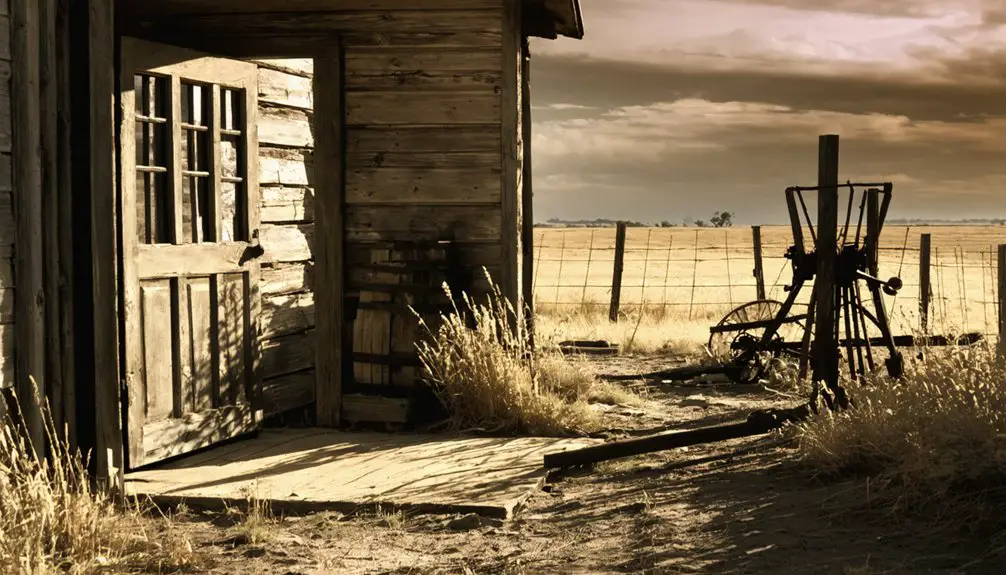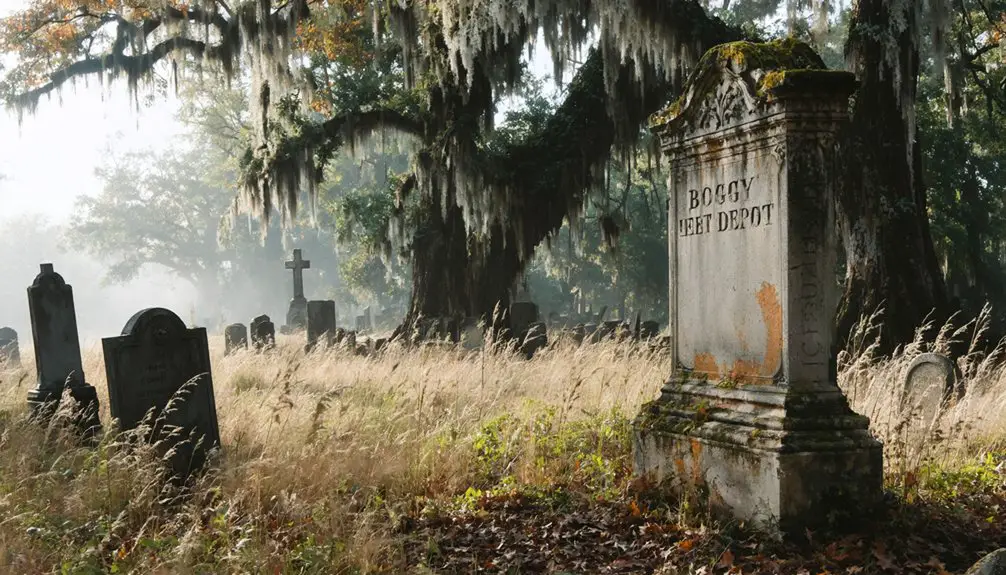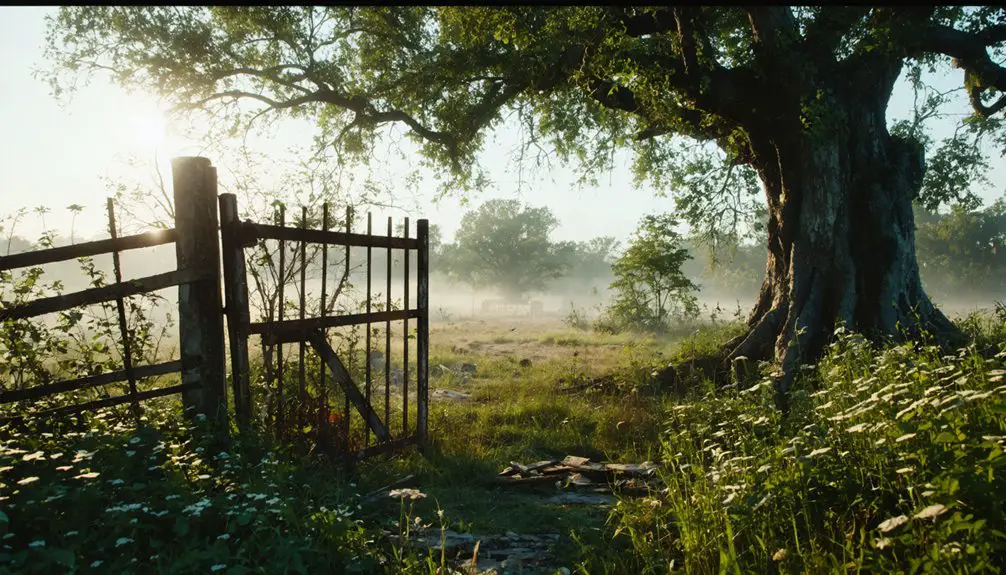You’ll discover Boggy Depot as an essential 1837 Chickasaw settlement that flourished at the intersection of the Texas Road and Butterfield Overland Mail routes. This strategic location between Clear Boggy and Sandy creeks made it a bustling commercial hub with diverse businesses, a Confederate commissary depot, and an important Native American trading post. Though the Missouri, Kansas and Texas Railroad’s 1872 bypass led to its decline, the site’s preserved cemetery and cultural memorials tell a deeper frontier story.
Key Takeaways
- Boggy Depot transformed from a thriving Native American trading post to a ghost town after being bypassed by the railroad in 1872.
- The settlement featured diverse businesses including an apothecary, mortuary, blacksmith, bakery, hotel, and dry goods stores before abandonment.
- Only a historic cemetery and cultural memorials remain at the site, which achieved National Register of Historic Places status in 1972.
- The town’s decline accelerated when merchants and residents relocated to nearby railroad-connected towns like Atoka for better trading opportunities.
- The site preserves Chickasaw and Choctaw heritage through interpretive signs and is currently managed by the Chickasaw tribe.
The Birth of a Frontier Settlement
When the Chickasaw Indians established Boggy Depot in 1837, they created what would become one of Indian Territory’s most significant frontier settlements. Following their forced removal from Mississippi and Alabama, they chose a strategic location between Clear Boggy and Sandy creeks, preserving their Chickasaw heritage while adapting to frontier challenges in their new homeland.
You’ll find the settlement’s location was masterfully selected, positioned along a ridge near the Texas Road and essential trails connecting to Fort Smith and Fort Washita. The site quickly proved its worth, becoming a critical depot for Chickasaw supplies by 1838. The town’s influence grew with the establishment of the first Chickasaw agency in the West.
Though technically within Choctaw Nation territory, the settlement’s position along the boundary established by the 1834 military road made it an ideal crossroads for both tribes. A post office opened in 1849, marking Boggy Depot’s growing importance as a regional hub.
Native American Heritage and Governance
Throughout its existence as a frontier settlement, Boggy Depot stood as a symbol to the complex dynamics of Native American governance in Indian Territory.
You’ll find that tribal governance played a vital role here, as the Choctaw Nation exercised its sovereign powers before the destructive policies of the Dawes Act and Curtis Act undermined their authority. The Tribal Council structure remained essential to maintaining cultural identity and political autonomy.
The Reconstruction Treaties of 1866 reshaped the political landscape by reducing tribal lands and permitting railroad construction through Choctaw territories.
As federal assimilation efforts intensified, you’d have witnessed the transformation of communal tribal lands into individual allotments, leading to significant cultural heritage losses.
The settlement’s location within Indian Territory meant it was directly affected by the dramatic shifts in Native American self-governance, from the autonomous period of the Five Civilized Tribes through the devastating era of land allotment that transferred millions of acres to non-Indian ownership.
Life in a Thriving Trading Post

At its zenith, Boggy Depot emerged as one of Indian Territory’s most dynamic commercial centers, where the convergence of major trade routes fostered a bustling marketplace economy.
You’d find a diverse array of businesses reflecting the town’s entrepreneurial spirit, from apothecaries and blacksmith shops to hotels and dry goods stores. The town’s strategic location along the Texas Road and Butterfield Overland Mail route made it an important hub for cultural exchanges between Native Americans and settlers. The establishment of the first Masonic Lodge above a local church demonstrated the town’s growing social institutions.
Local industries thrived through the operation of flour mills, cotton gins, and salt works, while millions in gold passed through the settlement’s trade routes.
You could witness merchants and travelers conducting business at the crossroads of commerce, making Boggy Depot an indispensable lifeline for both Confederate supplies and civilian trade throughout the region.
Civil War Era and Military Significance
As you explore Boggy Depot’s Civil War history, you’ll discover an essential Confederate military post that served as a major commissary depot supplying Confederate troops throughout the southern Indian Territory.
The strategic location along key military routes made it a significant hub for Chickasaw and Choctaw Confederate soldiers, with a Confederate banner flying proudly over the town for the war’s duration.
The site’s military significance peaked during the Battle of Middle Boggy Depot in 1864, where Union forces under Major Charles Willette engaged Confederate troops in a decisive conflict that resulted in significant Confederate casualties. The battle lasted only thirty minutes long, as the greatly outnumbered Confederate forces were forced to retreat.
Confederate Supply Operations
During the Civil War, Boggy Depot emerged as a significant Confederate military installation, serving as both a major supply commissary and strategic outpost in Indian Territory.
You’ll find that this 30-acre compound, complete with rows of log cabins and a prominently displayed Confederate flag, formed an essential link in the Confederate supply chain throughout the region.
The depot’s military logistics operation supported diverse Confederate forces, including Chickasaw and Choctaw soldiers who’d aligned with the Southern cause.
From this location, commanders distributed necessary supplies – food, ammunition, and equipment – to scattered Confederate units across Indian Territory.
Under General Douglas H. Cooper‘s command structure, the depot became instrumental in sustaining Confederate operations, despite the area’s remote location.
A ceremonial cannon, fired each evening, symbolized the depot’s organized military presence.
Strategic Military Routes
While the Confederate forces sought control over Indian Territory, Boggy Depot’s strategic location along essential military routes proved instrumental to their campaign.
You’ll find that the town sat at the intersection of significant transportation networks, including the military road connecting Fort Washita to Fort Smith, Arkansas, and the Texas Road’s north-south corridor.
The Dragoon Road’s crossing near a Confederate outpost by Middle Boggy enhanced military logistics, while General Leavenworth’s 1834 route to Fort Gibson strengthened regional mobility.
The town’s position between Clear Boggy and Sandy creeks created a natural hub for troop movements and supply lines. The area near Clear Boggy Creek would later inspire musician Jerry Cantrell to shoot his album cover artwork there.
If you’d examined the area during the Civil War, you’d have seen how these converging routes made Boggy Depot a critical command and control point.
Union-Confederate Local Conflicts
The Battle of Middle Boggy Depot marked a significant turning point in local Civil War conflicts when Union forces launched a devastating attack on February 13, 1864.
Major Willetts’ military strategy began with an artillery barrage at dawn, followed by a decisive cavalry charge that sent Confederate forces retreating toward Boggy Depot. The Brick Church served as a makeshift hospital to treat wounded soldiers from both sides during this period.
You’ll find that local alliances played a vital role in the region’s warfare, with Chickasaw and Choctaw soldiers forming the majority of Confederate forces under Captain Nail’s command.
While Union reports claimed 48 Confederate casualties with no prisoners taken, Confederate accounts disputed this number, citing only 11 deaths.
The battle’s aftermath revealed a grim discovery – many wounded Confederate soldiers were found with their throats cut, highlighting the brutal nature of these local engagements.
Economic Peak and Daily Life
During Boggy Depot’s peak prosperity from the late 1830s through the Civil War, you’d find a bustling commercial center where the Texas Road and Butterfield Overland Mail routes intersected.
You could witness merchants operating diverse establishments including an apothecary, mortuary, blacksmith, bakery, hotel, and dry goods stores, serving both locals and travelers.
The town’s economic significance was further enhanced by its agricultural processing facilities, including cotton gins, flour mills, and bois d’arc seed mills, which drew traders from across the region.
Trading Hub Activities
Located at a strategic crossroads in Indian Territory, Boggy Depot flourished as a vibrant trading center from the late 1830s through the 1860s, offering an extensive array of commercial services and agricultural processing facilities.
You’d find bustling trading routes converging at this hub, where market dynamics thrived through diverse enterprises. The town’s commercial infrastructure included an apothecary, mortuary, blacksmith shop, bakery, hotel, and dry goods store.
Local mills processed flour and cotton, while nearby salt works supplied essential goods to farmers and traders. You could’ve witnessed cowboys driving cattle along the Shawnee trail, merchants selling specialized bois d’arc seeds for fencing, and wagons crossing the toll bridge over Boggy Creek.
This economic significance made Boggy Depot the principal Confederate supply depot in Indian Territory during the Civil War.
Merchant Life Flourishes
While earlier settlements in Indian Territory struggled to establish economic footing, merchant life in Boggy Depot flourished spectacularly between the late 1830s and 1860s, creating a vibrant commercial ecosystem that served both Native and settler populations.
You’d find merchant relationships thriving through diverse industries, from flour mills to cotton gins, and trade dynamics strengthened by the town’s position at major crossroads. Local businesses included an apothecary, bakery, mortuary, and blacksmith shop, while a hotel catered to travelers along the Butterfield Overland route.
The Civil War brought increased activity as Boggy Depot became the primary Confederate commissary depot. The establishment of a toll bridge in 1866 and steady traffic from cattle drives further enriched the merchant class, even as they maintained close ties with Chickasaw and Choctaw communities.
The Railroad’s Impact on Decline

The construction of the Missouri, Kansas and Texas Railroad in 1872 dealt a devastating blow to Boggy Depot’s prominence when the rail line bypassed the town by 12 miles to the east.
The railroad effects rippled through the community as merchants and residents relocated to rail-connected towns like Atoka, seeking to maintain their commercial viability.
You’d have witnessed a dramatic trade disruption as stagecoach routes became obsolete and rail transportation dominated the region’s commerce.
The town’s decline accelerated as businesses closed or moved to railroad towns.
Cotton gins, flour mills, and general stores that once thrived in Boggy Depot couldn’t compete with rail-connected competitors.
Legacy in Stone: The Historic Cemetery
Standing as a silent sentinel to Boggy Depot’s vanished glory, the historic cemetery within Boggy Depot State Park serves as one of the last physical remnants of this once-thriving settlement.
Through cemetery preservation efforts, you’ll find the final resting places of notable figures like Choctaw Chief Allen Wright and Reverend Cyrus Kingsbury among the weathered tombstones.
These cultural memorials mark the convergence of Chickasaw and Choctaw heritage, offering tangible links to Indian Territory’s rich past. The cemetery’s stone markers, documented in Muriel Wright’s 1927 surveys, tell stories of the region’s early settlers and tribal leaders.
Today, as part of the National Register of Historic Places, the cemetery continues to educate visitors about Oklahoma’s Native American history while preserving vital genealogical records for future generations.
Preserving a Piece of Oklahoma History

Since earning National Register of Historic Places designation in 1972, Boggy Depot’s preservation has faced unique challenges stemming from complex land ownership issues and the site’s gradual transformation into a recreational area.
You’ll find that historical preservation efforts have focused on maintaining what remains of this significant cultural crossroads.
- The site’s mapping by Muriel Wright in 1927 provided essential documentation of the original town layout through firsthand accounts.
- The Oklahoma legislature’s consideration to transfer ownership to the Chickasaw Nation aims to improve site stewardship.
- Current preservation includes interpretive signs marking vanished buildings and institutions.
- The Chickasaw tribe’s management of the park area represents a return to their historical connection with the site.
Today, you can explore Boggy Depot Park’s trails while discovering the cultural significance of this Native American and settler settlement.
Frequently Asked Questions
Were There Any Famous Outlaws or Lawmen Associated With Boggy Depot?
Like a quiet sentinel on the frontier, you won’t find any documented outlaw legends or lawman stories here – historical records show the town focused on trade, Native American governance, and military operations instead.
What Happened to the Buildings and Materials After the Town Was Abandoned?
You’ll find no original structures remain – they succumbed to building decay over decades. While some materials were likely repurposed locally, most wooden and brick components simply deteriorated into the landscape.
Did Any Major Epidemics or Natural Disasters Affect Boggy Depot?
Like a clean slate in history’s record, you won’t find any documented major epidemics or natural disasters that greatly impacted the town’s fate – its decline came from economic factors instead.
What Native American Ceremonies or Traditions Were Practiced in Boggy Depot?
You’ll find tribal councils held ceremonial practices including seasonal rituals, warrior preparations, and governance ceremonies. The site’s cultural significance centered on Chickasaw and Choctaw traditions of prayer, mourning, and treaty-making.
How Many People Lived in Boggy Depot During Its Peak Population?
While exact population statistics aren’t documented, you’ll find historical evidence suggests several hundred to low thousands of residents during the mid-1800s peak, when it served as a significant Chickasaw trading center.
References
- https://en.wikipedia.org/wiki/Boggy_Depot
- https://kids.kiddle.co/Boggy_Depot
- https://www.redriverhistorian.com/post/boggy-depot
- https://npgallery.nps.gov/GetAsset/7cffd5c4-9386-4bbb-bef3-056d0e43a177
- https://www.okhistory.org/publications/enc/entry?entry=BO002
- https://www.okhistory.org/publications/enc/entry?entry=AT005
- https://revfrankhughesjr.org/images/OLD_BOGGY_DEPOT_by_Murial_Wright.pdf
- https://www.okhistory.org/publications/enc/entry?entry=AM010
- https://www.okhistory.org/learn/government6
- https://en.wikipedia.org/wiki/Indian_Territory



